10 Superyacht Concepts With Outrageous Features, From a 560-Foot Track to a Private Marina
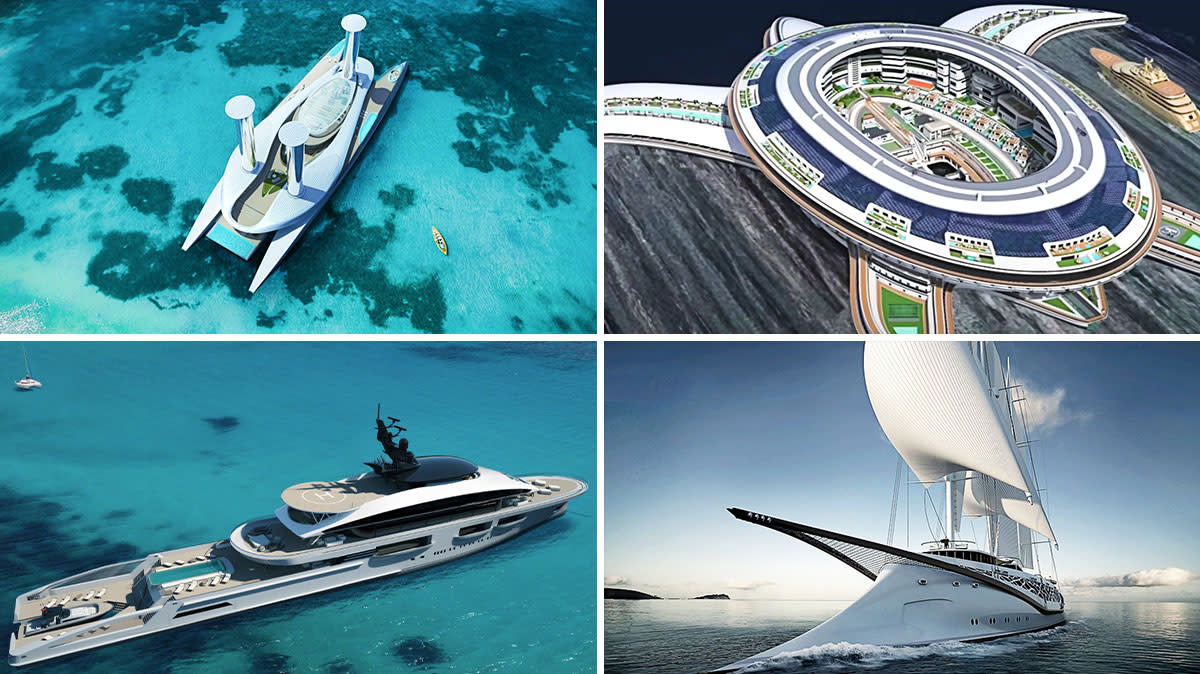
Among the most outrageous yachts ever built, Sailing Yacht A and Yas are top of the list. The polarizing designs are defined by their exteriors—A for its fortress aesthetic and the former navy frigate Yas for its dolphin-like appearance. Love them or loathe them, they break from conventional yacht design and show what can be done with a little fresh thinking. That’s exactly what concepts are intended to do, and some of the world’s most outrageous examples take it to the extreme.
“Yacht concepts drive human evolution in maritime adventure,” says Micca Ferrero, owner of ICON Yachts. “It is one of the oldest and purest forms of work, as humans have been preparing to take to the sea for centuries in search of a better world. Each concept carries a small part of our future at sea.”
More from Robb Report
This New 100-Foot Superyacht Is a Modern Cruiser With the Soul of a Rugged Workboat
13 People Have Been Arrested for Starting a Forest Fire in Greece From Their Superyacht
But the concepts have gone beyond simple sea vessels. From the Airyacht, with its detachable upper blimp structure, to U-Boat Worx’s Nautilus that can travel underwater at 10 knots, superyachts are no longer limited to the surface. Shape, size, amenities and propulsion are all up for grabs, and some of the most eyebrow-raising examples pave the way for the yachts of tomorrow.
Here are 10 of our favorite outrageous yacht concepts ever launched.
Best of Robb Report
Sign up for Robb Report's Newsletter. For the latest news, follow us on Facebook, Twitter, and Instagram.
Click here to read the full article.
Pangeos — The World’s Largest Floating Structure

Italian design studio Lazzarini is known for its far-fetched ideas, which include a swan-shaped yacht and floating seaports. Pangeos is its interpretation of the world’s largest floating structure. The 1,800-foot-long “terayacht” (which also measures 2,000 feet across at its widest point) is named after Pangea, a supercontinent that existed 335 million years ago. This Pangea is estimated to accommodate 60,000 guests. The premise is an emissions-free city that can sail around the world. Designed in the shape of a giant turtle clad in solar panels, the concept includes multiple structures with a rooftop shopping mall, restaurants, and houses. There are also gardens, pools, and a large beach club, as well as helipads, hangars and marinas to store helicopters, toys, and tenders. Pangeos is powered by nine electric motors of 16,800 hp each, with the “wings” drawing more power from the waves and wind. Lazzarini estimates the build cost would be $8 billion.
VY.01 — Standout Feature: Indoor Garden
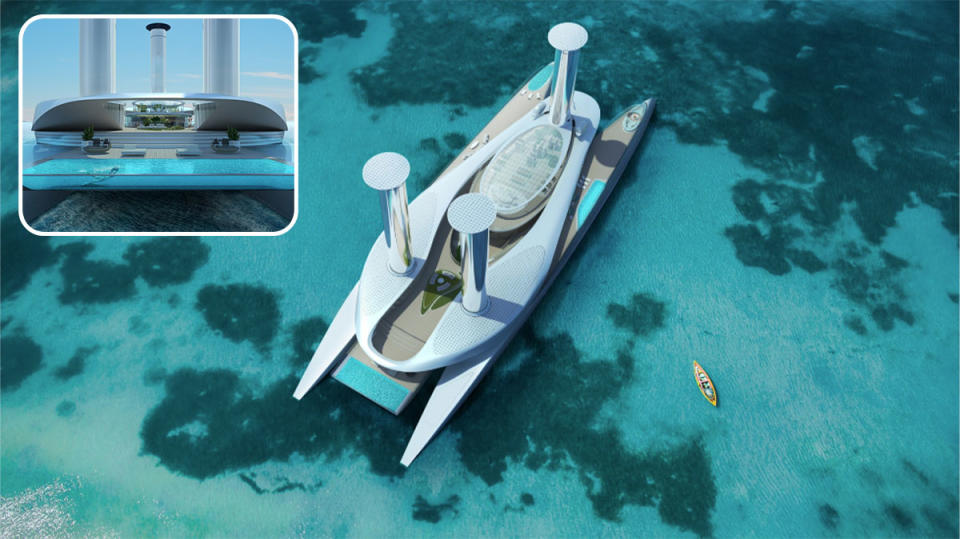
Gardens and superyachts don’t typically mix. It can be challenging to keep plants alive at sea since gardening requires substantial care and resources. But that didn’t stop German architects 3deluxe from penning VY.01, a low carbon-emission superyacht concept with a greenhouse and vegetable garden. Billed as a “paradisiacal biotope,” the concept catamaran focuses on onboard self-sufficiency. In addition to a hydrogen fuel-cell system and electric propulsion, the vessel has solar panels on the rooftop to generate clean energy for the seawater desalination system that provides water for the plants. Other features include large deck spaces, open-plan living, a saltwater pool, and a mini marina for tenders and toys.
Domus — Standout Feature: An Experimental Open Plan Layout
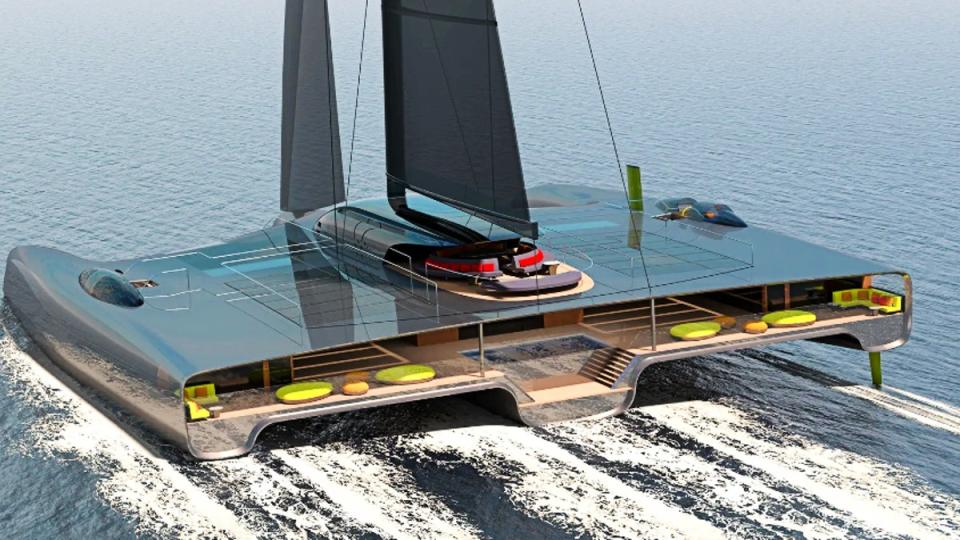
This 131-foot-long solar sailing trimaran by Rob Doyle Design and Van Geest has 8,500 square feet of interior space, more than double the volume of other yachts with similar lengths. Domus, meaning a single-story home divided into two parts, is defined by a flat and wide superstructure, containing multiple guest areas that lead to a central atrium. The full-beam design is spread across two decks, with two owner’s suites that each have adjoining salons. There is also a cinema, gym, spa, and pool. When sailing, Domus will be able to heel at an angle of two degrees to reduce drag while also guaranteeing a comfortable guest experience with minimal rolling. It also uses a combination of solar power, hydro-regeneration technology, and hydrogen fuel cells for unlimited range and zero emissions. If that’s not enough, it’s fitted with a sail for extra wind power.
EXPV — Standout Feature: Floating Glass Walkway Connecting Two Deckhouses
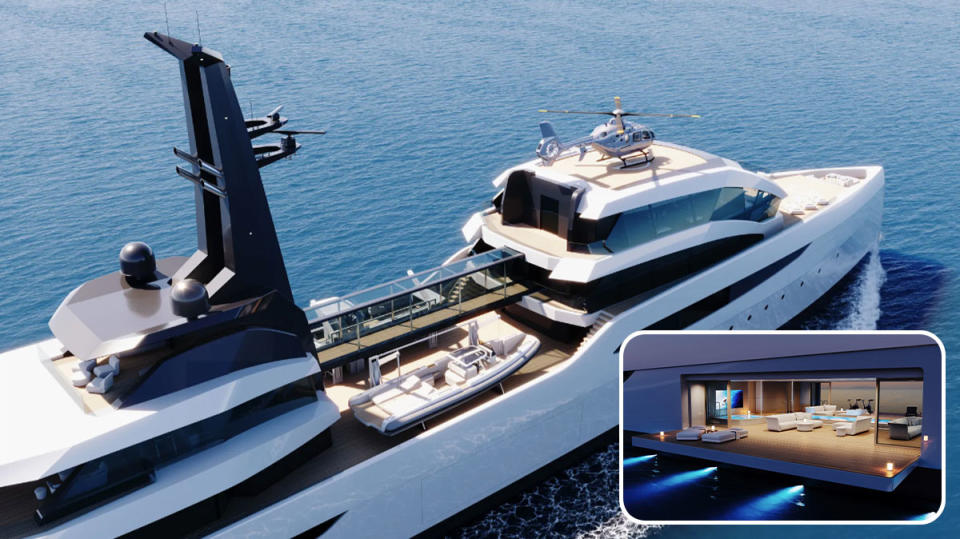
Over the years, Feadship has developed engineered yacht concepts that not only bring something new to yacht design, but also are ready to be built. The 285-foot EXPV, which the Dutch yard developed in collaboration with British studio Harrison Eidsgaard, is an explorer with a difference. The vessel has two deckhouses connected by a suspended glass walkway that separates the private owner’s quarters from the guest areas. The full-beam owner’s apartment, measuring 44 feet across, has an observation room, a helideck, and a private foredeck sun lounge. The other six guest cabins face the sea. On the lower deck, the beach club has folding platforms on both sides, an indoor swimming pool, and a skylight. A tender deck is located directly below. The mast holds a two-person pod that travels above the radar domes for exceptional views. The yacht also has hybrid diesel-electric propulsion.
Cantharus — Standout Feature: Underwater Lounge
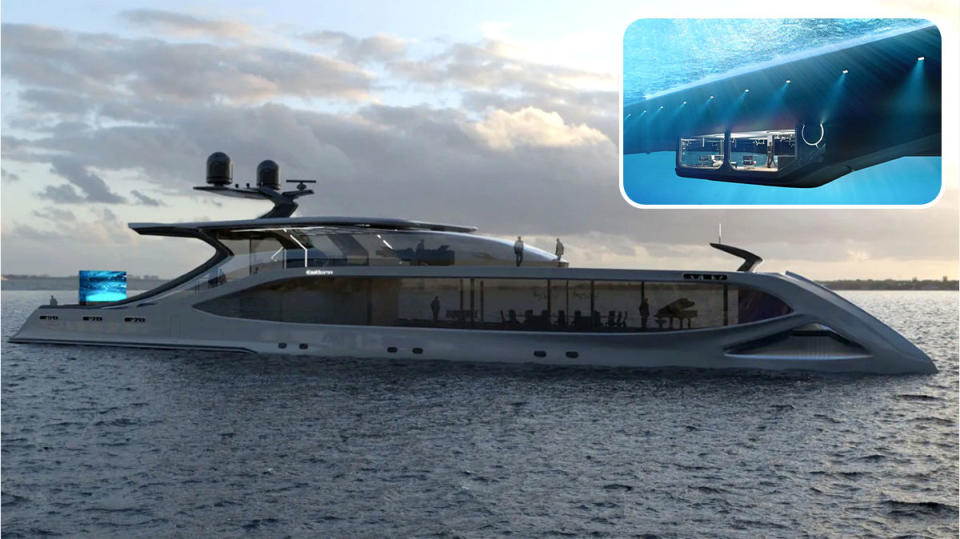
Cantharus is about being immersed in nature. American designer Darin Osborne’s Cantharus is a vessel with unrestricted views of the ocean, above and below deck, to encourage guests to be at one with their surroundings. The 226-foot concept has an underwater lounge and office amidship that converts into an owner’s cabin. The space holds a piano, formal dining table, and entertainment system. More panoramic vistas are on the upper bridge. On the main deck aft, there is a Jacuzzi that doubles as a stage, and a bar and DJ booth. At night, underwater lights illuminate the ocean, shining a spotlight on the behemoths of the deep.
Galileo² — Standout Feature: A Private Marina

Described as the “catamaran that costs $500 billion to build,” the 656-foot Galileo² stretches the imagination in all directions. German naval architects Beiderbeck Designs, whose most notable builds include the 305-foot Eos and 233-foot Skat, conceived the multihull during the pandemic. It was clearly ahead of its time. Equipped with a methanol powerplant, it also has a 19,000-nautical-mile range, a retractable restaurant, and a 262-foot pier for the 38 guests to take walks at sea. Along with 75 crew, the yacht has a private marina with 260 feet of dock space—enough for 25 boats, submersibles, and toys. Other key features include an outdoor cinema, a hospital, and an Olympic-sized swimming pool.
Phoenicia — Standout Feature: Articulated Helipad

Igor Lobanov’s sailing concept Phoenicia catches the eye with a reverse bow, a raised bowsprit, and an Arabian-inspired cutout on the superstructure that casts shadows across the yacht’s exterior decks. Even more dramatic are the masts on the main deck behind a glass-walled gallery. The yacht, a bridge between old and new, fuses a large traditional sail rig with an articulated helipad that unfolds from the roof of the owner’s suite. At night, 33 laser lights shine into the water, giving the impression that the yacht has two decks of oars.
Project L — Standout Feature: An Underwater Glass-Encased Owner’s Suite
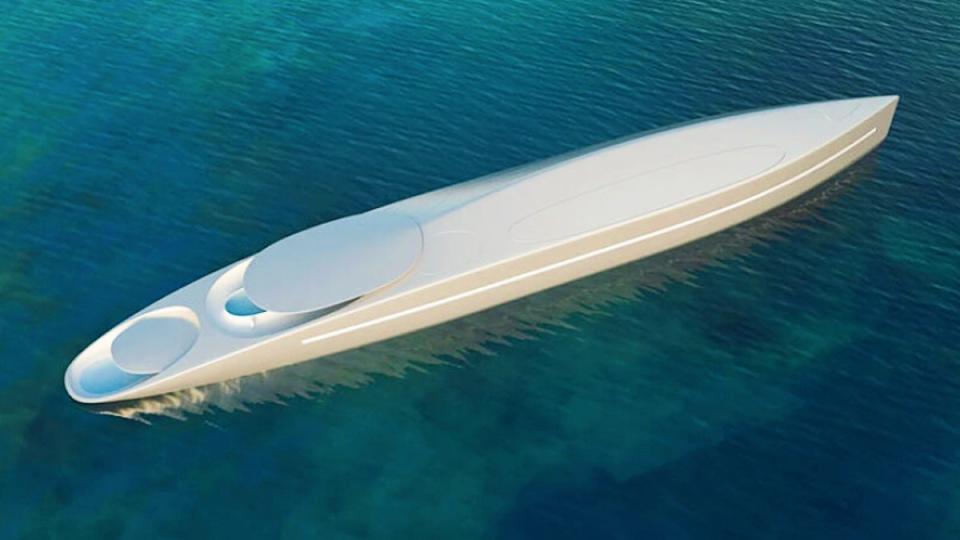
French designer Thierry Gauguin is a long-time collaborator of Philippe Starck, with projects that include Venus, the 260-foot Feadship built for Steve Jobs. His ultra-modern 394-foot concept Project L is his first solo design. Conceived for long, oceangoing passages with diesel-electric propulsion, it is fitted out with a glass-encased underwater owner’s suite at the bow. The bullet-like exterior blends the naval architecture of a sailing vessel with motoryacht convenience. Outdoor deck areas are limited to the small sun deck and an extendable beach club at the stern, both of which have pools. Yet the design also includes a dinghy bay, a heliport, a car garage, and even an underwater escape pod for Bond-like exits.
Ocean Odyssey — Standout Feature: A 590-Foot Running Track
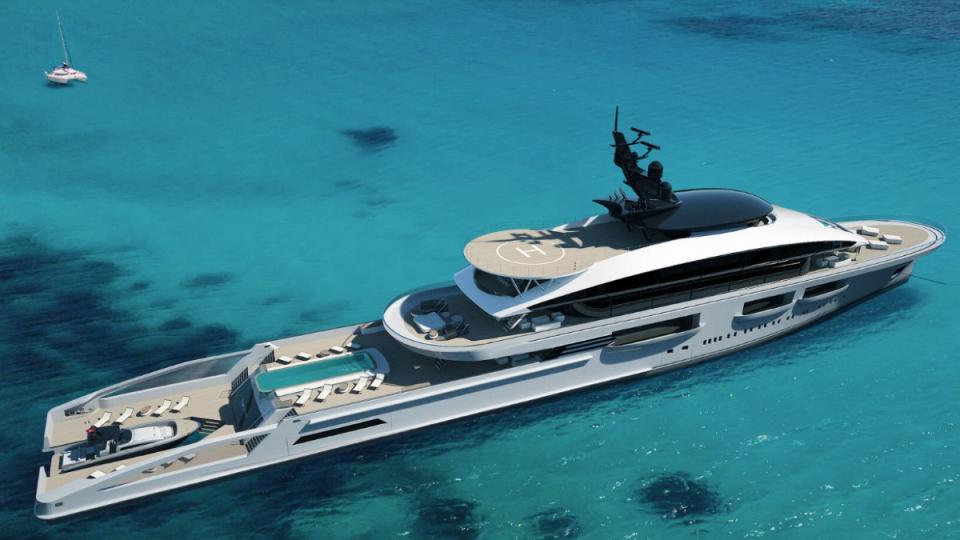
Penned by Italian designer Marco Casali as part of his 2020 “Owner for a Day” initiative, the 360-foot Ocean Odyssey is a floating hub of operations based on features requested by a yachting journalist. The vessel is defined by a two-level glass superstructure, which conceals a high-tech media center and a signature 590-foot running track. Its two-level stern works as a swimming pool (with lounges) on the upper-level beach club), as well as a private port to accommodate a custom 50-foot tender in a floating slip. More seating is found on the foredeck and bridge deck, while a helipad on the top deck allows for easy guest transfer anywhere in the world.
Protean 95 — Standout Feature: An Adaptive Platform
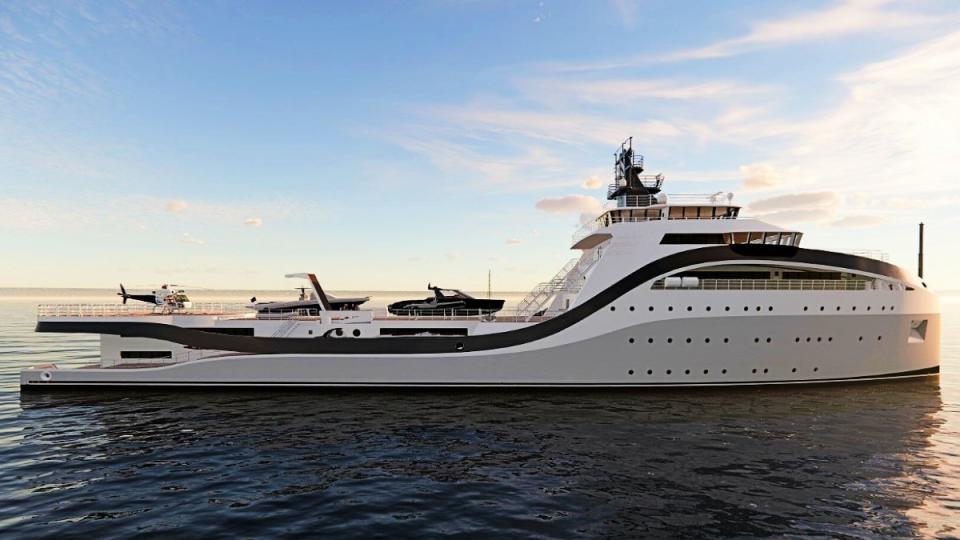
The 312-foot Protean 95 is all about flexibility. Designed by Dutch studio CBSPRO Maritime to meet a variety of owners’ needs, it can be used as a support vessel, an explorer yacht, or a mothership for sportfishing tournaments and sailing regattas. The hybrid electric yacht can also serve as a floating laboratory and research vessel for oceanographic expeditions, helped by its 8,000-nautical-mile range. The open aft deck is a multifaceted heli-facility that can accommodate an 18-passenger helicopter. It also has a helipad, under-deck equipment hangar, and refueling area, as well as space for a submersible, multiple tenders and other pleasure craft. Amenities for the 20 guests include a spa, gym, cinema, and pool.


